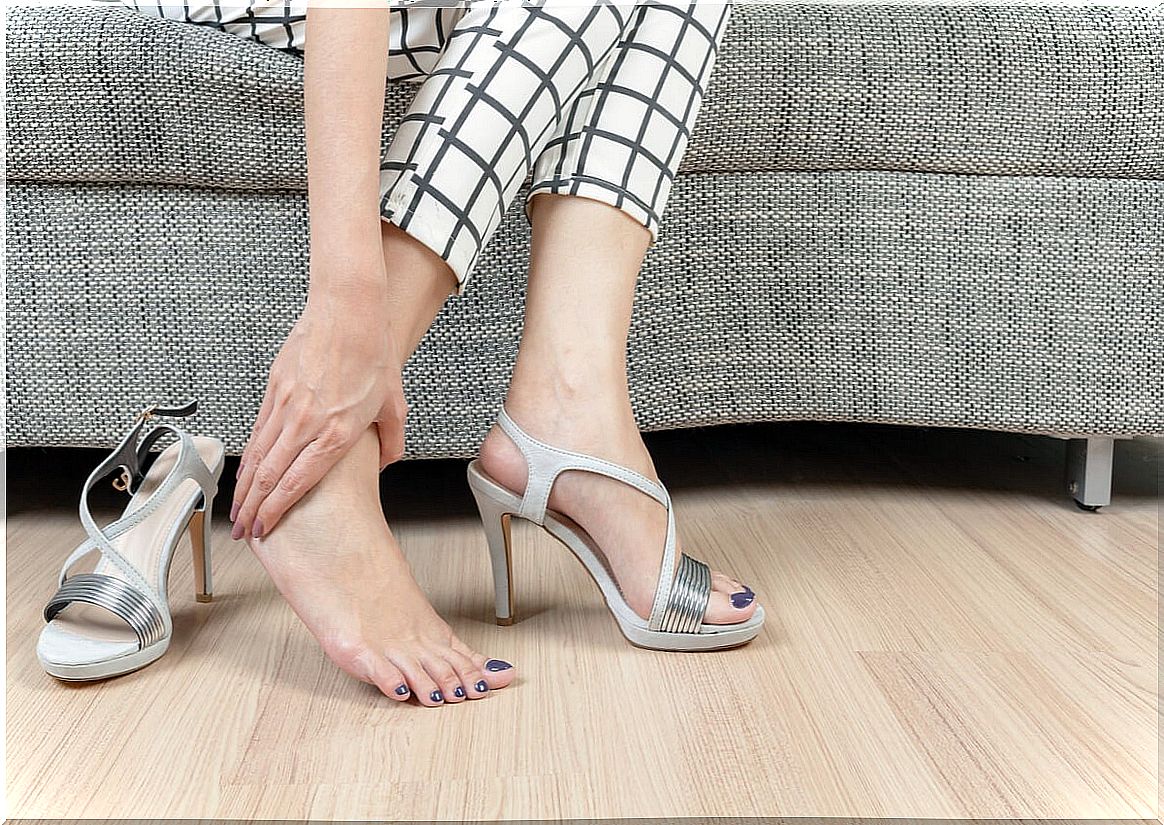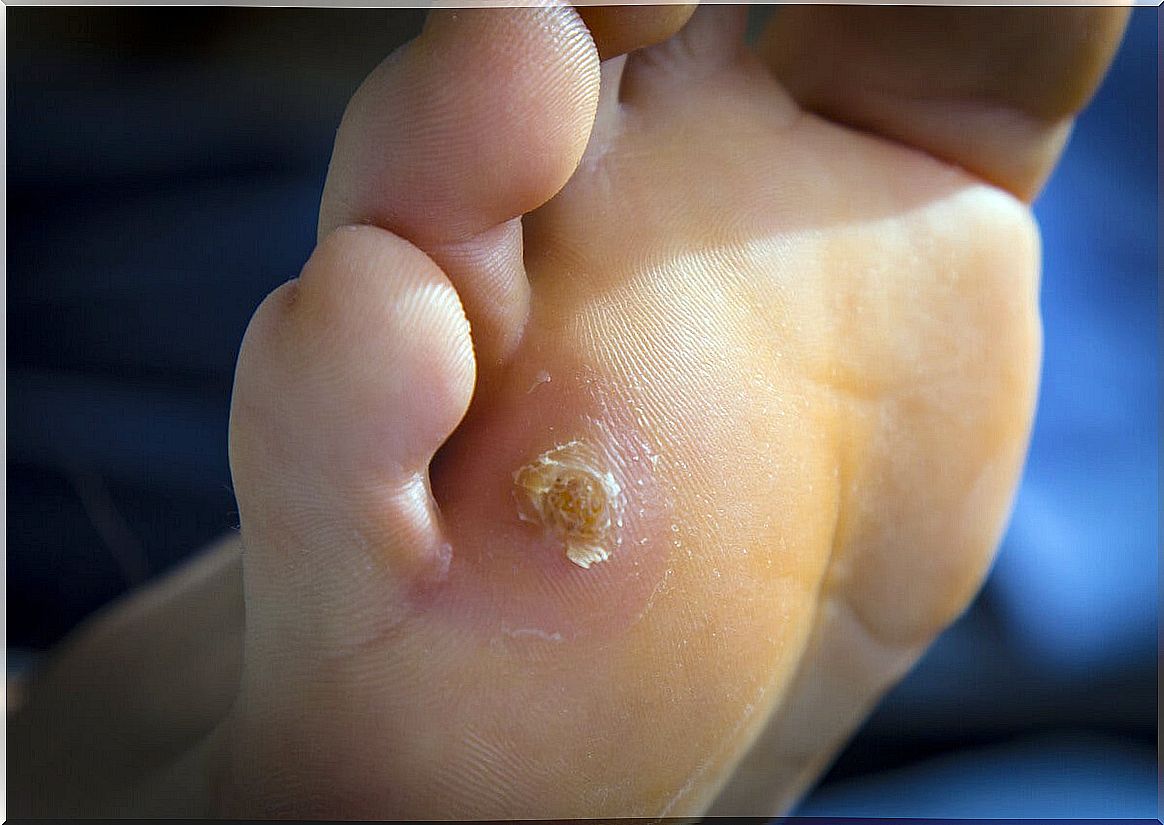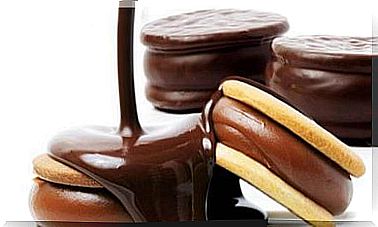What Are Corns And Calluses And Why Do They Appear?
Corns or calluses are a type of localized hardening with greater prevalence on the soles of the feet. They are also often known as helomas .
This condition is often seen in athletes and in patients who are exposed to uneven frictional force from footwear or gait problems. This includes older adults, patients with diabetes, and amputees.
What are corns or calluses?
Corns or calluses are common, uncomfortable, and thickened skin lesions. They result from repeated mechanical trauma due to friction or pressure forces that occur on the skin.
People with dark pigmented skin are more likely to develop corns. In addition, they are more closely located on the feet, in the regions of the back of the fingers, the last interdigital space and the soles.
What are the symptoms and signs?
This type of hyperkeratosis usually presents as a dry, hard, rough, flesh-colored papule with a whitish center. This central region is called the nucleus . In turn, they are preferably located on a bony prominence.
They are painful when walking and standing, but asymptomatic to the touch. On the other hand, as keratin growth and thickening increases, corns and calluses can cause severe pain.
Corns are sometimes difficult to distinguish from plantar warts. However, if the doctor exerts finger pressure perpendicular to the callus, the callus will come into contact with the bony prominence and the patient will feel pain. This maneuver is usually not painful in the case of warts.

Why are corns generated?
Inappropriate shoes, abnormal foot mechanics, and high levels of activity produce pressure and friction that lead to corns and calluses. That is why athletes are more prone.
Therefore, the repeated friction and pressure of the skin that covers the bony prominences leads to a thickening that will lead to the callus or callus. The increase in thickness is a protective body reaction that produces an excess of the horny epithelial layer to prevent ulceration of the skin.
This explains the preferential location next to the condyles of the metatarsals and phalanges, as well as the appearance of calluses in patients with a foot deformity. It is the lower extremities that are most affected by the pressure they bear.
Read also: How to remove dead skin?
Types and classification of corns and calluses
There are two main variants of this type of condition. However, a third is often mentioned that manifests as multiple painless plugs within the plantar calluses, in areas of the soles of the feet that do not support pressure.
Heloma hard
Hard heloma is the most common type of callus. It is most frequently located on the lateral and dorsal aspect of the fifth toe, as well as on the dorsal aspect of the interphalangeal joints of the lesser fingers.
Soft heloma
Soft heloma is a painful hyperkeratotic lesion that is observed in most cases in the interdigital spaces, especially in the fourth. This location often leads to maceration of the same and, sometimes, to the appearance of a bacterial or fungal infection.
What is the treatment of corns?
Injuries usually disappear when the causative mechanical forces are removed. Treatment aims to reduce pain and discomfort. Despite this, corns are often recurrent.
Topical treatments for corns or calluses
Topical keratolytic medications, including salicylic acid, may be applied to corns. Dressings made of 20% and 50% urea, silver nitrate, and hydrocolloids are also used in this indication.
These techniques are more effective for some injuries. In turn, topical keratolytic agents can also facilitate lesion removal by softening calluses. Physical removal of corns has been shown to improve quality of life and pain outcomes.
Ablative laser
Lasers can be used to treat corns, rather than exfoliating them with a scalpel. However, recurrence of the lesions is observed in some patients, especially if the triggers are maintained.
Conservative treatment
Any mechanical problem and deformity should be treated with proper conservative treatment. That is, it is about using suitable footwear and soft cushions that reduce friction and improve comfort.
Surgical
This surgical approach is aimed at removing the underlying cause of calluses, such as bony prominences. It is generally indicated in the event of failure of other conservative treatment modalities, according to American Family Physician publications .
Homemade tips to remove corns
It can be very helpful to soak the corns in warm water for 20 minutes. After this, gently rub the callus with your finger or a pumice stone.

How to prevent the appearance of corns and calluses?
Management actually begins with prevention. Therefore, poorly fitting shoes and mechanical trauma to the affected area should be avoided. This is especially true for athletes with intense training.
Corns are not caused by viruses and are not contagious. In addition, nail trimming should be indicated to avoid any pressure or repeated trauma that could lead to the development of lesions.
The risk of corns and calluses
Although corns and calluses are a chronic and recurring problem, most of them gradually disappear when repeated friction or pressure is removed. However, if the corns do not go away or if they started to cause severe pain, the patient should be examined by a dermatologist or podiatrist.
In people with diabetes or another condition that causes poor blood flow to the feet, there is an increased risk of complications. These patients need a strict control with revision of their extremities to detect in time the problem that can lead to ulcers.









